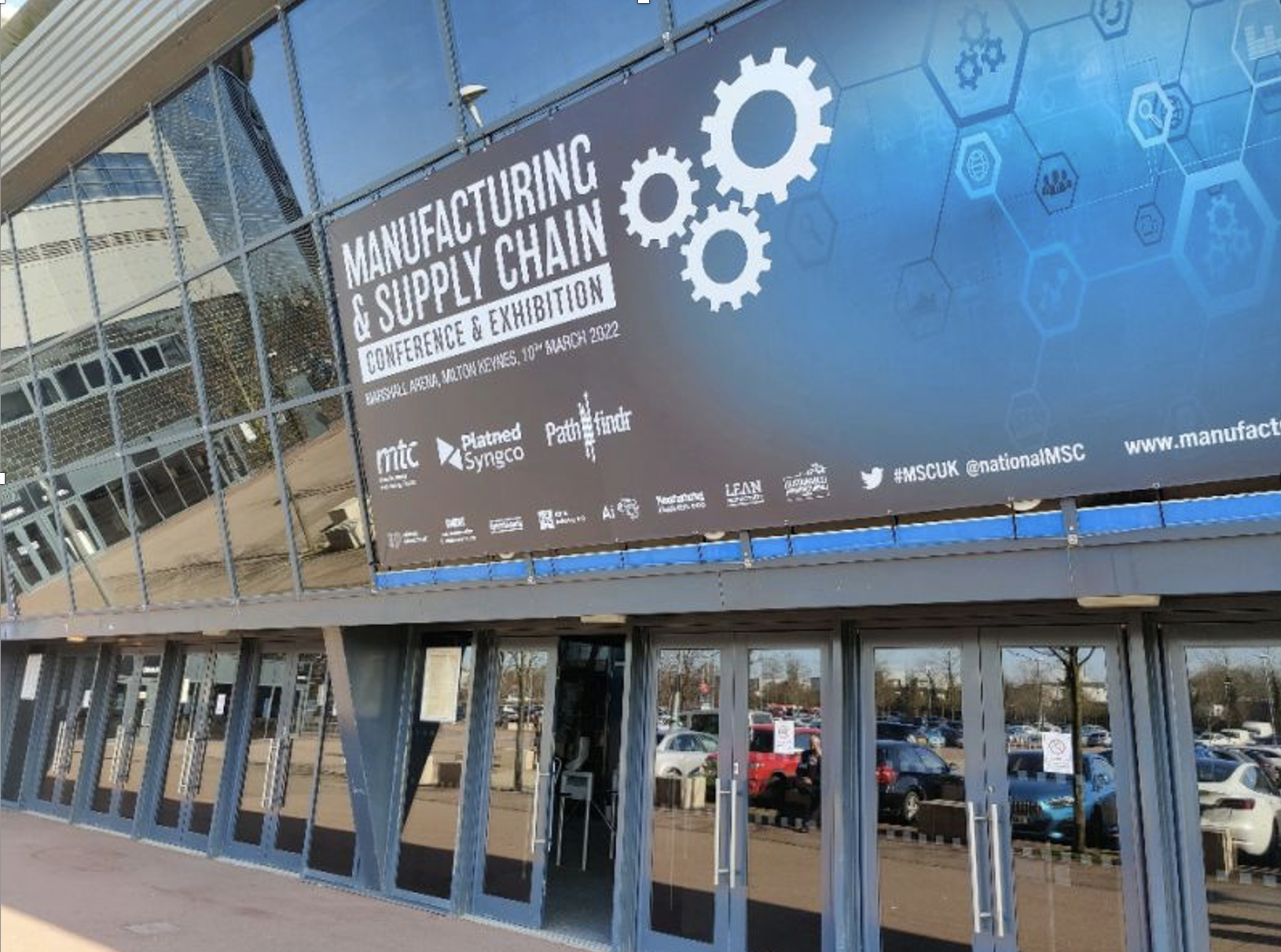Manufacturing & Supply Chain Conference and Exhibition
14/04/2022

Milton Keynes hosted the Manufacturing & Supply Chain Conference and Exhibition and we (Cranfield) hosted the supply chain and logistics stage.
The Manufacturing and Supply Chain Conference and Exhibition took place on 10 March 2022 in Marshall Arena, Milton Keynes Stadium. Cranfield University was among the exhibitors, and our Centre for Logistics, Procurement and Supply Chain Management moderated the presentations on the Supply Chain and Logistics Stage.
Image Source: https://www.linkedin.com/feed/update/urn%3Ali%3Aactivity%3A6908059608141955072/
It felt unusual to be back in public spaces with hundreds of people in an exhibition after two years with the COVID Pandemic. It was exactly two years ago, on 11 March 2020 that the World Health Organization declared COVID-19 a pandemic, which is followed by local, regional, and national lockdowns mandating to work from home and ceasing all travel and social interaction.
Walking around exhibition stands was unfamiliar as much as exciting. We held conversations on the future of supply chains which have been tested in many ways over the past two years: first Brexit, then US-China trade war, then COVID, then Russia’s Invasion of Ukraine… If we learned anything from the past two years, it is the value of agility, the ability to reorganise and respond to disruptions, and the pressing need to improve our supply chains for the better.
The supply chain and logistics stage at the conference held presentations and discussions simultaneously with many other stages. The presenters and the audience changed every 20mins, making it a dynamic floor appealing to a range of diverse topics in supply chain and logistics.
The first talk was by Innovate UK, on strengthening the UK’s power electronics, machines, and drives supply chains. An investment of £80 million committed to the area, with Rolls Royce and Safran expected to increase their footprint significantly. Power electronics, machines, and drives are relevant to the transport and energy sectors. Skills shortages in the sector are in the order of thousands. The funders are looking for short, high-impact supply chain projects. An example is McLaren, who are using this fund to design their next generation inverters.
Then followed the Manufacturing Technology Centre’s talk on the fact that we can no longer run our supply chains assuming business as usual. This was the most crowded talk for the day, the audience overflowing to the exhibition area to listen to the presentation and ask questions. Three readiness levels are put forward: technology, manufacturing, and supply chain. The lack of coordination between the research and development department and the supply chain function leads to failures when a new technology is adopted.
We heard from Visagio on how to setup data for digital success. It is a common experience that master data are incomplete, inaccurate, and not real-time. Typical bad data problems include missing data, wrong data, wrong syntax, wrong template, or duplicate entries. The mismatch between materials master data and supply chain data leads to higher procurement costs. By only improving the quality of data, it is possible to achieve 5-10% higher service levels and 2-5% lower inventory levels. Accurate, complete, and timely master data is the foundation of supply chain analytics that can give a competitive edge to the company. Exel’s presentation on material requirements planning vs master production scheduling underscored the importance of data preparation and suggested data cleaning and processing exercises taking up to 18 months before the software could be deployed in a company.
Shippeo highlighted the importance of visibility for resilience, adapting to a constantly changing environment. Short to medium term approaches to increase resilience are dual sourcing and optimising inventory and logistics. In the long term, companies are recommended to adopt a control tower approach to have full visibility of the supply chain and digital twins to run disruption scenarios and prepare contingency plans for various outcomes of a wide range of uncertainties. The role of data and visibility becomes much a significant differentiator for producers of commodity products where everything else may be much similar to that of the competitor. Both short- and long-term recommendations are expected to increase agility in sourcing and manufacturing.
Surefire Logistics, a recruitment company for warehouse workers drew our attention people side of leaving a job, the relevance of the word of mouth, and the necessity of keeping workers happy and healthy at all levels. Presenteeism, which is physically attending work but mentally not being fully engaged, appears to be an increasing problem for the sector. The organisational culture should be shifted for presenteeism behaviour to be not perceived as normal and the work to continue even if the boss is not around.
Smart Recruit Online highlighted a range of online tools available to companies who are looking to find and hire the best talent in the logistics sector. They provide an applicant tracking system for the hiring process for low skilled workers and unskilled labour market. Market drivers that make such a tool viable are noted as the reduced supply of workers because 1.5 million people are estimated to have returned to Eastern Europe after Brexit, changing demand dynamics such as the increased online purchases necessitating higher volumes of picking, packing, and last mile delivery operations in the sector, and sentiment changes: the sector’s failure in attracting young talent. Typical performance metrics for hiring unskilled logistics workers are cost per application, time to offer, time to hire, cost per hire, and first-time fill rate; all of which are claimed to improve with online hiring systems.
After the lunch break, we heard from the Eastern Cyber Resilience Centre, which is a non-for-profit organisation that highlights the cybersecurity threats to companies, small and medium-sized enterprises (SMEs), in particular. Around 600K SMEs are anticipated to be vulnerable to cyber-attacks, yet unaware that they may even be attacked. Cyber resilience is the new term to replace cyber security because it is impossible to be 100% protected. Many actors in the supply chain, suppliers, and customers, have been attacked yet they do not know how they are compromised. Sometimes it is easier for the company to be attacked not only via remote software but a person physically visiting the premises of the company and deploying to software directly within the company’s network.
Another highlight of the stage was the presentation by Mosaic International on how to manage supply chains in Southeast Asia. China, US, and India will be among the top economies. The UK has formally applied to access the Comprehensive and Progressive Agreement for Trans-Pacific Partnership (CPTPP) which is a free trade agreement between Australia, Brunei Darussalam, Canada, Chile, Japan, Malaysia, Mexico, Peru, New Zealand, Singapore, and Vietnam. When working in global supply chains, the costs of logistics, delays, and disputes should be considered and compliance risks along with damages to reputation should be recognised. The recommendation from Mosaic is to send local agents to audits instead of sending people from the UK to avoid the language barrier. The way of doing business is essentially different. While in the UK it may take about 10 min and a contract for a business transaction, in Asia the parties would invest significant amount of time in getting to know each other and no business transaction can be completed in as short time as it can be over in the west.
The last talk on the stage was by Jacob Bolton, who had an intriguing title: Dead ends, lost means: the supply chain of abandonment. Jacob presented work in progress on cargo ships that are left across the world owing to becoming non-operational. The research has economic, politic, and environmental implications since these cargo ships left behind are not appropriately decommissioned. A related metric proposed by the researchers is supply chain thickness, which is a proxy for the number of people, sectors, and nations associated with the flow of goods and services on the supply chain.
Overall, it was a glorious day in Milton Keynes, one of the first events after the two-year long COVID-19 restrictions. We have several learnings from the past two years: 1) We need think about the resilience of our operations, minimum cost operating model fails under disruption. 2) Our most valuable assets are people, and the pandemic triggered the great resignation, with millions of people quitting jobs for something different. The new working environment need to ensure work-life balance and organise work around life, rather than life around work. 3) The adoption of Industry 4.0 technologies, automation, and robots will continue across supply chains at a faster pace than before until when they become a natural part of running operations.
Categories & Tags:
Leave a comment on this post:
You might also like…
Preparing your work for Turnitin submission
Before submitting your work into Turnitin for similarity checking, if you have used referencing software then you may need to take some important steps first. Mendeley and Zotero integrate with MS Word by embedding field ...
The fast track to supercar engineering: My Cranfield journey
It’s been a dream come true to work on some of the world’s most prestigious supercars – the Aston Martin Valhalla, McLaren 750 & Artura, the GMA T.33. But every successful ...
Automotive Engineering: From student to hypercar innovation at Rimac
We sat down with recent graduate Thomas Perrin, to discuss how his year on the MSc in Automotive Engineering at Cranfield University propelled him from the lecture hall directly into the ...
What this year at Cranfield really meant to me
Every Cranfield journey is unique. In this alumni reflection, Zachea Scicluna shares what her year at Cranfield truly meant, from facing uncertainty to gaining hands-on experience in industry-backed projects. I’ve been reflecting (and delaying) ...
Preparing for assignments and exams?
Sorry! We know it seems a bit mean to mention the exams in January rather than looking forward to the break before it! However, we know many of you will be thinking about your forthcoming ...
Screening for FTSE 100 companies on Bloomberg
So you’re researching an index and need some data on its constituent companies? Bloomberg’s Equity Screening tool makes light work of this, not just for the FTSE, but for indices, exchanges and sectors worldwide. Type EQS ...







